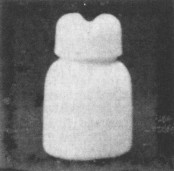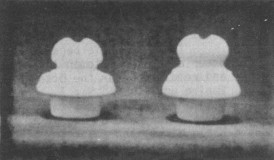Foreign Insulators
by Marilyn Albers
Reprinted from "INSULATORS - Crown Jewels of the Wire", September 1981, page 3
Saudi Arabia and Israel
I want to talk about two different
porcelain insulators this month, one coming from Saudi Arabia and the other from
Israel. Most of this information was given to me by George Cowan of Houston,
Texas, a young single fellow 24 years old, who went to work for General Electric
two years ago right out of college and was given a work assignment in Saudi
Arabia lasting several months. During his off periods George had time to look
around a bit, which was very much to his liking, because he is a real history
buff. He is also my son Mark's best friend, so of course he knows I collect
foreign insulators. It also occurred to me that maybe he was afraid to come home
without them! Good thinking!!
The first one you see pictured below is a white
porcelain and comes from Saudi Arabia. George helped himself to four like this
with the permission of the telephone company in the city of Riyadh. There were
several of these with wires still connected just lying on a dump heap. They had
been taken off an old telegraph line and were no longer being used.

Incuse
marking: 54-12
Reminding you again that George did well in history class he had
this to say when I asked him if he could tell me anything about them:
"In
1517 Arabia began to be occupied by the Ottoman Turks, and remained under the
Ottoman Empire until World War I. The Ottoman Empire was allied with Germany and
Austro-Hungary in World War I, and lost much of its territory as a result. Their
loss of Arabia was due to combined British-Arab efforts, in which T. E.
Lawrence, better known as 'Lawrence of Arabia', played a great part, as did
British General Edmund Allenby. After World War I the Arabs, left to work out
their own fate (but under English protection), became united under Ibn Saud,
resulting in the nation of Saudi Arabia.
"My first thought is that these
insulators are possibly of German or Austrian make and were installed on a
telegraph line during the days of the German-Ottoman alliance, but I cannot be
certain. The insulators came from the area around Riyadh, the present capitol,
located in the central part of the country.
"The present day Saudi
telephone system is maintained and operated under the direction of Canadian
nationals, for reasons unknown to me and to the various telephone company
employees I contacted while in Saudi Arabia."
Here I must add a few
comments of my own. Since the only markings on the insulator are a series of
incuse numbers, it is almost impossible to tell its exact origin. However, its
general shape is typical of those found in Germany, Hungary, Switzerland,
Turkey, Denmark, or Russia, indicating that one of these countries may have
supplied insulators to Arabia. One thing is certain -- they are unlike those
manufactured in England, the country that afforded Arabia protection during the
1920's.
The next picture shows two white porcelain insulators, nearly alike,
from Israel. The one on the left came to Houston in George Cowan's suitcase!
During another off period he had taken a run through Israel! This insulator,
too, has only incuse numbers on the crown and no other markings. The general
shape looks very German to me, or even Japanese, except that you almost never
see a Japanese insulator without a manufacturer's logo or a "Made in
Japan" marked on it somewhere.
The insulator on the right belongs to Lu
Farin of Decatur, Texas, and was a gift from a friend who brought it back to her
from Israel. It has no markings at all.

Left insulator incuse marking: 4491
Quoting George Again:
"The insulator from Israel was taken from a steel
power pole in the city of Tiberias. Tiberias lies along the northern shore of
the Sea of Galilee and is mentioned in the New Testament. Tiberias was built in
18 A.D. by Herod Antipas in honor of the Roman Emperor Tiberias. It was at
different times a Roman, Arab, Crusader and Turkish city, but is now, of course,
Israeli. The pole was lying on the ground about 20 feet from the water's edge
and had apparently been knocked down. There were identical poles still standing,
but there were no lines being supported by them."
This insulator from
Israel is really very special to me because of where it came from, not that it
would have any great stories to tell, but it's just the idea!
| 